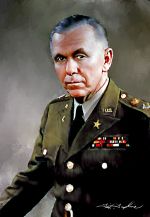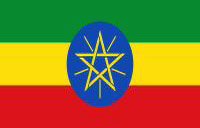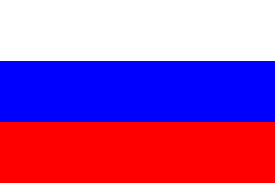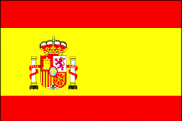
George Marshall
The Nobel Peace Prize 1953
Delegate U.N., ex-Secretary of State and of Defense, General President American Red Cross, Originator of "Marshall Plan"
Biography
By Austin Givens, Vice President at Pavement Services Corporation, Dallas/Fort Worth Area TX
George Catlett Marshall Jr was born on the last day of the year 1880 in Uniontown, Pennsylvania. He was the youngest of three to George Catlett Marshall Sr and Laura Emily Marshall. Marshall could have joined his father at his successful coal business but opted to become a solider instead. He graduated from the Virginia Military Institute (VMI) in 1901. After serving a tour in the Philippines he went on to be the Honor Graduate from the Infantry-Calvary School at Ft. Leavenworth in 1907 and graduated first in his class at the Army Staff College in 1908.
Marshall’s military and political career spanned most of the major historical events of the 20th Century, from World War One (WWI) through the Korean War. He was a fresh-faced Army Officer during the Philippine insurrection. He served on the staff to the General of the Armies John J. Pershing during WWI. Before World War Two (WWII) he became the 15th Chief of Staff of the United States Army (September 1939 – November 1945) under President Franklin D Roosevelt. After WWII President Harry S Truman appointed him the 50th United States Secretary of State (January 1947 – January 1949) where he orchestrated the Marshall Plan. Also, under Truman, during the Korean War, Marshall served as the 3rd United States Secretary of Defense (September 1950 – September 1951). He is the only person in history to serve in all three of these significant positions. He is also the first Army General to receive the prestigious rank of five stars.
Marshall’s more historical achievements took place during and after WWII when he served as Chief of Staff and Secretary of state. In July of 1938 Marshall was Brigadier General serving on the War Plans Division in Washington D.C. It was there he attended a conference where he was the only person to voice his disagreement with President Roosevelt’s decision to support England by providing them with aircraft over sending them a large ground unit. Many believed that Marshall’s disapproval of the Presidents idea would be the end of his career, but it had the opposite effect and led to Roosevelt’s recommendation and appointment of Marshall for Chief of Staff.
Marshall was sworn in as Chief of Staff on September 1, 1939, coincidentally the same day the German Army launched its invasion on Poland. Upon becoming Chief of Staff, Marshall inherited an Army of 189,000. By 1942, not long after the United States had joined the Allies in WWII, Marshal had increased the army fortyfold to the largest Army in American History, now with over eight million soldiers. Conducting an Army with such rapid growth in a time of war did not come without condemnation. Marshall was heavily criticized for shortening the basic training of all troops (except for the airborne division) and sending ill prepared soldiers overseas.
Even with heavy criticism regarding the training of soldiers most people believed nobody else could have handled the sheer size and growth of the army better than Marshall. Marshall was expert organizer and had a knack for inspiring and recognizing the potential of other officers. Marshall was responsible for appointing many American generals with top commands during WWII, including both Dwight D. Eisenhower and George S Patton. Winston Churchill characterized Marshall as the “organizer of Allied Victory†and Time magazine named him man of the year in 1943.
Two years after resigning as Chief of Staff, President Truman appointed Marshall as the Secretary of State in 1947. After a speech Marshall gave at Harvard University, he became the spokesman for the United State's ambitious plan to rebuild Europe, affectionately called The Marshall Plan. The Marshall Plan was designed to aid in the economic recovery of European countries after WWII and reduce the spread of Communism within them.
Marshall became Time Magazine’s Man of the Year for the second time in 1947 for his early efforts to help rebuild Europe. In 1953 he was awarded the Nobel Peace Prize for the accomplishments made in Europe’s rebirth from the Marshall Plan. George Marshall is the only career office in the United States Military to receive this honor.
Marshall retired from service in 1951 to his home, Dodona Manor, in Leesburg Virginia where he lived until his passing in 1959. He was twice married, first to Elizabeth Carter Coles in 1902 until her untimely passing in 1927. Marshall remarried in 1930 to Katherine Boyce Tupper and had three stepchildren.
Marshall Plan
The primary objective of the Marshall Plan was to aid in the economic recovery of European nations after WWII by rebuilding war-torn regions, removing trade barriers, modernizing industry and improving European prosperity, but it also had a secondary agenda of preventing the spread of Communism.
After WWII, George Marshall was appointed Secretary of State under President Harry S. Truman, and on June 5th 1947, Marshall gave a speech at Harvard University where he described the dysfunction of the European economy after WWII and offered American aid to promote recovery and reconstruction in Europe. Stating:
“It is logical that the United States should do whatever it is able to do to assist the return of normal economic health in the world, without which there can be no political stability and no assured peace. Our policy is directed not against any country or doctrine but against hunger, poverty, desperation and chaos. Its purpose should be the revival of a working economy in the world so as to permit the emergence of political and social conditions in which free institution can exist.â€
This speech did not outline exactly what the United States would do or how much it would spend. It basically told Europe that if they organized a program, cooperated and coordinated with the United States, then the United States would financially support them. Only European, and primarily British, media were invited to attend the address and the speech was broadcast in its entirety on the BBC.
The speech received immediate response and acceptance from the British Foreign Secretary, Ernest Bevin and French Foreign Minister, Georges Bidault. With their approval, the Committee of European Economic Co-operation (CEEC) was created. Members of the Soviet Union media were also invited as the Soviet Union was the other major allied power during WWII, but since previous negotiations regarding an economically self-sufficient Germany with the Soviets had already been rejected, their acceptance was not expected.
Marshall feared that if poverty were to continue throughout war-torn Europe that communist temptation would feed upon the weak. He believed that economic stability would provide political stability. His fear obviously had some merit as the Soviet Union and other Eastern communist countries rejected the plan and refused to join the CEEC and even created a counter plan called the “Molotov Plan†that would provide Soviet subsidies and trade to other socialist countries.
In July of 1947, the CEEC (which now comprised of 16 European countries) met in Paris to negotiate what form the American aid would take and how it would be divided. The CEEC initially asked for $22 billion in aid, but President Truman cut it to $17 billion and submitted it to congress as a bill called the Economic Cooperation Act (ECA) (official name of the Marshall Plan). The bill was met with bipartisan support and Truman signed the Economic Cooperation Act into law on April 3, 1948.
The funds would roughly be divided among participating countries on a per capita basis over the next three years, ending in 1951, but more amounts were given to countries with major industrial power as the belief that was that revival of those industries would be essential Europe’s economic recovery. More aid would also be provided per capita to countries that were part of the Allied nations during the war and less to those who were part of the Axis or remained neutral. The United Kingdom received the largest portion of funds from the Marshall Plan (26%), then France (18%), followed by West Germany (11%).
The money from the Marshall Plan was transferred to participating governments and were jointly administered by the local governments and the ECA. Each European capital had an ECA representative from America that would advise on the process. The local governments and ECA envoys would cooperate and regularly meet with business and labor leaders to examine the economy and determine where aid was most needed.
The bulk of the money was initially used to replenish exhausted resources lost during the war. By mid-1951 close to $10 billion had been spent on imports of raw materials, semi-manufactured products, food, feed, fertilizer, machines, vehicles, equipment and fuel. While these goods not only immediately helped strengthen Western Europe, they helped the American economy as well since most of the goods came from the United States.
These goods alone could not revitalize the European economy though. While the majority of the funds was allocated to providing those resources, the meat and heart of the Marshall Plan was in counterpart funds that helped establish local currency and the Technical Assistance Program (TAP) which promoted leading industry tactics and standards.
The ECA required any recipients of the counterpart funds to invest 60% of these funds into industry. These government administered funds could then be leant to private enterprises and business that were geared toward rebuilding. Those companies were obligated to repay the loans and upon doing so the government would lend the money back out to other businesses in need. This process has continued to this day in many of the countries. In Germany this fund is still active and has made low interest loans to German business amounting to over DM 140 billion.
The Technical Assistance Program (TAP) was actually founded before the Marshall Plan in in 1940 as part of the rebuilding effort. It regularly worked in conjuncture with and was regularly funded by the counterpart funds from the Marshall Plan. The intent of the TAP was to have the US Bureau of Labor Statistics (BLS) make studies of labor productivity both in the United States and the countries receiving aid from the United States. Counterpart funds were used to send businessmen and experts to United States to tour American factories, farms, stores, and offices. While much of the TAP was used to educate improve the Europeans productivity and industry standards, another large portion and uncommon (at the time) idea was to share industry data and information.
From 1948 to 1952 Europe experienced its fastest growth in history. Industrial production increased by 35%, agricultural production surpassed pre-war levels and the poverty and starvation that existed in Europe as result of the war was gone. There is much debate among historians and economists about how much the Marshall Plan really had an effect on the resurrection of Western European economy. Revitalization efforts were already underway when the Marshall Plan took effect. Most believe that it certainly sped up Europe’s recovery and that many European countries would not be as prosperous today without it.

Discover Your Abilities and Aspirations!
 $10 $25 $50 $100 Other
$10 $25 $50 $100 Other
Tax Exempt 501(c)3 Non-Profit Organization
Any Currency
“…the peace that is found in libraries and laboratories…” - Louis Pasteur
Copyright © 2023 Ganga Library Inc. All Rights reserved.;

Photo US Govt. Wiki. Painting Tim Tompkins PaintHistory.com
Name: George Catlett Marshall
Birth: 31 December 1880, Uniontown, PA, USA
Death: 16 October 1959, Washington, DC, USA
Residence: USA
Award: Delegate U.N., ex-Secretary of State and of Defense, General President American Red Cross, Originator of "Marshall Plan"
Portion of Cash: 1/1
Biography
What I learned from Nobelist George Marshall













